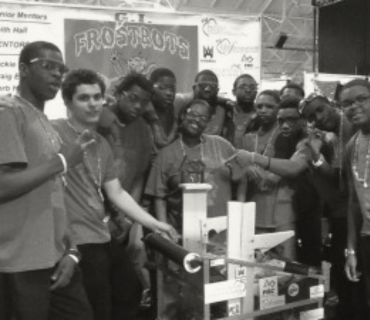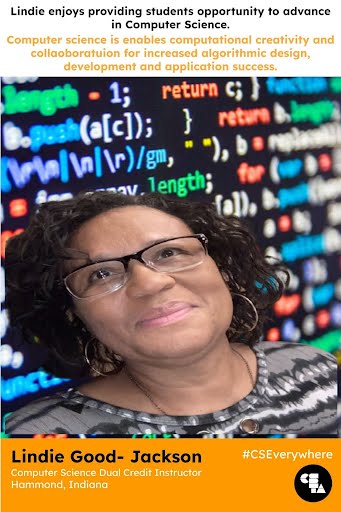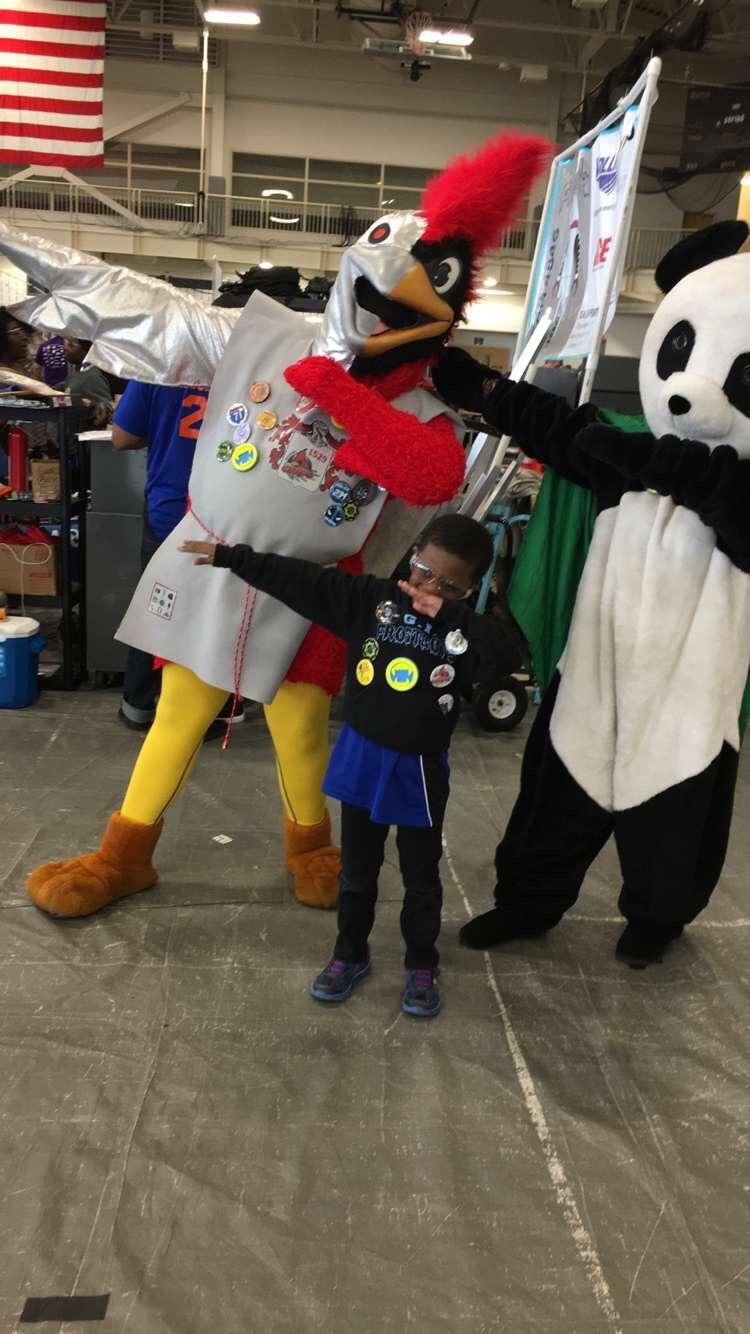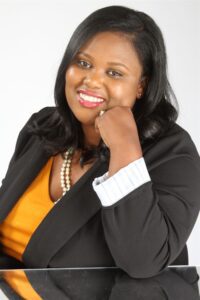
In 2012, I desired to have a position that would give me the flexibility to focus on my son’s early childhood development while also helping my community.
Full Story
 In 2012, I desired to have a position that would give me the flexibility to focus on my son’s early childhood development while also helping my community. In January 2013, I was extended the opportunity to join a local school in my hometown to start up their FIRST Robotics team. The school received funding from the 21st Community Learning Centers grant, and this robotics team served as an additional curricula activity for students to join after school hours. The Director, Mrs. Lindie Good-Jackson, allowed me to assist with this program. Our first robotics team was all boys, who lived in the inner city with varying ethnicities; 1 Hispanic, 2 Jamacians, and 9 Black/African-Americans. Many of these young men lived in single-parent homes and received free and reduced lunch. They were exposed to gun violence, increasing high school dropout rates, and illicit drug activity on a daily basis. Mrs. Good-Jackson’s passion for giving inner-city youth exposure to opportunities outside of the city borders and allowing them to visit colleges and businesses gave them insight into the various CS/STEM careers. Her belief in me inspired my passion to open the eyes of these young men despite their living conditions or what was happening in their community. Our journey began with excitement but was soon met with shock as we began competing regionally.
In 2012, I desired to have a position that would give me the flexibility to focus on my son’s early childhood development while also helping my community. In January 2013, I was extended the opportunity to join a local school in my hometown to start up their FIRST Robotics team. The school received funding from the 21st Community Learning Centers grant, and this robotics team served as an additional curricula activity for students to join after school hours. The Director, Mrs. Lindie Good-Jackson, allowed me to assist with this program. Our first robotics team was all boys, who lived in the inner city with varying ethnicities; 1 Hispanic, 2 Jamacians, and 9 Black/African-Americans. Many of these young men lived in single-parent homes and received free and reduced lunch. They were exposed to gun violence, increasing high school dropout rates, and illicit drug activity on a daily basis. Mrs. Good-Jackson’s passion for giving inner-city youth exposure to opportunities outside of the city borders and allowing them to visit colleges and businesses gave them insight into the various CS/STEM careers. Her belief in me inspired my passion to open the eyes of these young men despite their living conditions or what was happening in their community. Our journey began with excitement but was soon met with shock as we began competing regionally. As we networked with other surrounding school districts, we discovered they had far more access to resources than our students. Our students needed the same robotics kits, coding software, programming courses, and classroom setup to give them the opportunity to learn and apply various hands-on engagement activities to excel in the curricula. Despite the adversity we all felt, this did not stop them from excelling during their first competition. I saw the team build their own brotherhood and make positive connections, especially in the Gaming World. As true leaders do, they began to lend a helping hand to those who were in need of academic support for overall team success. We didn’t leave our first competition empty-handed, they applied the skills they learned and won the Rookie Inspiration Award!
This opportunity was not just an eye-opener for me but also for my son, who had developed a relationship with his brothers, “The Team”. His long hours of sitting and watching these young men build, program, and compete was the spark that ignited his interest for STEM. During the competitions, he’d cheer them on, dance with fellow teams’ mascots, or be found in the pit collecting each team’s button. Not only did I see part of my dream fulfilled with flexibility for my family but also fostered the love of computer science and stem to a new generation of technology students. The team was amazing and my family was a direct beneficiary.
Y ears later, my son was excited to become more involved like his “brothers.” During 4th grade, he applied to join the VEXRobotics team at his elementary school. He got in! He enjoyed the hands-on activities with his robotics team. As he competed across his school district and region, our conversations grew deeper than what the ranks, wins, and losses of competition held. We began to talk about his observation of being the only Black child on the team. He often commented on how discouraging this truth was. As a parent and teacher, it made me wonder, “Why?” Was it that Black kids weren’t interested? Were their parents informed? Was it some type of requirement or restriction that would limit their interest from joining a robotics team?
ears later, my son was excited to become more involved like his “brothers.” During 4th grade, he applied to join the VEXRobotics team at his elementary school. He got in! He enjoyed the hands-on activities with his robotics team. As he competed across his school district and region, our conversations grew deeper than what the ranks, wins, and losses of competition held. We began to talk about his observation of being the only Black child on the team. He often commented on how discouraging this truth was. As a parent and teacher, it made me wonder, “Why?” Was it that Black kids weren’t interested? Were their parents informed? Was it some type of requirement or restriction that would limit their interest from joining a robotics team?
 ears later, my son was excited to become more involved like his “brothers.” During 4th grade, he applied to join the VEXRobotics team at his elementary school. He got in! He enjoyed the hands-on activities with his robotics team. As he competed across his school district and region, our conversations grew deeper than what the ranks, wins, and losses of competition held. We began to talk about his observation of being the only Black child on the team. He often commented on how discouraging this truth was. As a parent and teacher, it made me wonder, “Why?” Was it that Black kids weren’t interested? Were their parents informed? Was it some type of requirement or restriction that would limit their interest from joining a robotics team?
ears later, my son was excited to become more involved like his “brothers.” During 4th grade, he applied to join the VEXRobotics team at his elementary school. He got in! He enjoyed the hands-on activities with his robotics team. As he competed across his school district and region, our conversations grew deeper than what the ranks, wins, and losses of competition held. We began to talk about his observation of being the only Black child on the team. He often commented on how discouraging this truth was. As a parent and teacher, it made me wonder, “Why?” Was it that Black kids weren’t interested? Were their parents informed? Was it some type of requirement or restriction that would limit their interest from joining a robotics team?All too often I have witnessed Black/Latinx students being forced out of educational clubs because they do not meet the “expectations” of the coaches. Some guidelines for acceptance include but are not limited to: behavior evaluations, grade requirements, and school attendance. However, with further evaluation, these are common struggles for many of these students. These questions ran through my mind: Are schools and coaches truly passionate about increasing membership and helping students to achieve an equal level of participation? What if recovery plans could be put in place to help students overcome these obstacles? For example, expanding student club membership criteria to include the following:
- 30 minutes of peer-to-peer support for homework/missing assignments.
- Allowing students to contribute to the team goals and do weekly check-ins.
These are just a few ideas on how to foster support when students apply and don’t meet certain academic requirements. Students need to feel like they belong. All students need a positive outlet and safe place to help them fulfill their potential and build their character. When denied the opportunity to become involved students become more vulnerable to negative outlets that can hinder their maturity and creativity. Factors like accessibility to STEM/CS programs are projected in the journal piece written for ACM Transactions on Computing Education in the February 2022 edition, entitled “Can Computing Be Diversified on “Principles” Alone? Exploring the Role of AP Computer Science Courses in Student’s Major and Career Intentions”. The authors share factors that affect minority student enrollment in STEM/CS programs such as AP-related courses in science and noting the imbalance of the number of minority student involvement as related to other races in more affluent areas. This coincides with the observation mentioned earlier, although efforts are occurring there are so many factors that contribute to the problem that we need to plan to overcome them.
My firsthand account with my initial robotics team proves the data of key factors reflective of being afforded broader educational and career opportunities beyond environmental constraints. Almost 10 years later, these young men are enrolled in college, working for companies like Subaru as safety team members, serving in the United States Armed Forces, and married with their own families, and bright futures. I am glad to have witnessed the positive outcomes as a robotics coach, educator, and youth advocate but I know so much more can be done.
About the Author
 Leontae Gray Ward is a proud Purdue University Alumni that received her B.S. in Mechanical Engineering Technology. She is passionate about affording scholars high-quality computer science programming and other STEM opportunities. Currently, she is a Project Lead the Way Instructor for the School City of Hammond in Indiana. Leontae has also served a 4-year term as a board member of Engineering Technology Educators of Indiana. Her passion for STEAM encouraged her to establish her company, S.T.E.A.M. City Tek Exec, where she partners with other organizations and travels throughout urban communities to host STEM camps for youth. Leontae is eager to find and pursue opportunities that will allow her to continue to advance in this field and make a huge impact in the community. In her spare time, Leontae loves exploring music, engaging in her children’s educational and recreational activities, and spending time with her family.
Leontae Gray Ward is a proud Purdue University Alumni that received her B.S. in Mechanical Engineering Technology. She is passionate about affording scholars high-quality computer science programming and other STEM opportunities. Currently, she is a Project Lead the Way Instructor for the School City of Hammond in Indiana. Leontae has also served a 4-year term as a board member of Engineering Technology Educators of Indiana. Her passion for STEAM encouraged her to establish her company, S.T.E.A.M. City Tek Exec, where she partners with other organizations and travels throughout urban communities to host STEM camps for youth. Leontae is eager to find and pursue opportunities that will allow her to continue to advance in this field and make a huge impact in the community. In her spare time, Leontae loves exploring music, engaging in her children’s educational and recreational activities, and spending time with her family.Reference
Sax, L, Newhouse, K, Goode, J, Nakajima, M., Skorodinsky, M., Sendowski, M. 2022. Can Computing Be Diversified on “Principles” Alone? Exploring the Role of AP Computer Science Course in Students’ Major and Career Intentions. ACM Trans.Comput. Educ. 22,2, Article 18 (February 2022), 26 pages.

